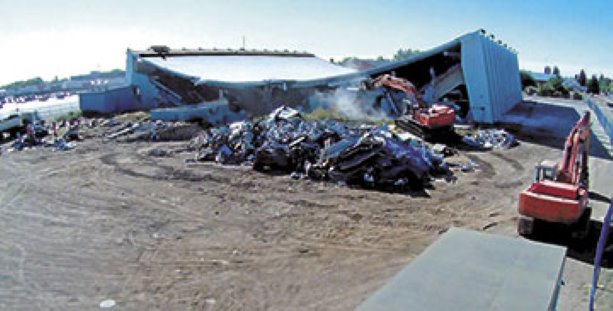Known for an unusual roof structure marked by an inverted curve, the Moose Jaw Civic Centre, aka The Crushed Can, has finally been retired and demolished.
The arena, which was awarded the Massey Medal for architecture, was designed by Saskatchewan architect Joseph Pettick and Vancouver structural engineer J.L. Miller to replace an existing arena destroyed by fire.
The building was designed to cut construction costs by eliminating interior supports. Instead, the roof was supported by a series of two-inch cables suspended from 30-foot concrete A-frames forming the walls.
The curved suspension ceiling spanned 192 feet and was covered by steel decking and a layer of concrete ballast. The roof descended to within 12 feet of the surface of centre ice. Measuring 214 feet long, the stadium could seat an audience of 2,750, who would theoretically enjoy an unimpeded view of the surface below.
“I played Junior Hockey there and when you were in the top seats you could only see to the glass on the boards,” says Bill Babey, project manager for SCR Developments, the company responsible for redeveloping the site. “The seats were smaller than normal and you didn’t have a lot of leg room. It was a weird structure.”
The building opened in September 1959 with a performance by Louis Armstrong. It remained the home of the Junior Hockey Moose Jaw Warriors until last year, when it became clear that maintaining the decaying arena was becoming too expensive.
“The maintenance man told me that when the Warriors were in the playoffs last year he lived in fear that the temperature outside would warm up,” says Babey. “The roof leaked and when it did, it would drip in a straight line and freeze an inch-and-a-half thick in front of the net.”
The facility was offered up to private investors but there were no takers who agreed to preserve the building. Plans for the site include new retail facilities that replicate some of the design features of the arena.
SCR sub-contracted the demolition to Silverado Demolition & Excavating of Saskatoon. The environmental decommissioning of the building was relatively uncomplicated, says Babey, because the city had already removed most of the asbestos insulation when the building’s mechanical systems were replaced 10 years earlier.
Initial plans for demolition included implosion, but insurance proved too costly. “We also looked at cutting the suspension cables, and six or seven other ways to bring it down,” says Babey. “We finally decided to hammer away at the structure at the bottom with excavators outfitted with jackhammers so we could squash the integrity of the structure and let it fall into itself.”
Structural demolition began in August before a large crowd of local residents and TV cameras.
“Some of them seemed to believe that the building was going to come down in an hour,” says Babey. “The guy on the tractor asked me, ‘what do they think is going to happen?’ We thought we had to give them something, so we poked the concrete with the excavator and it goes ‘tink’ and a chunk of concrete falls out and goes ‘thonk.” It was a real anti-climax.”
As demolition proceeded, crews encountered massive rebar two inches in diameter.
“The columns were a couple of feet thick and six feet deep, so when we started we thought it would be painful to bring them down,” says Babey. “But at more than 50 years of age they just started to crumble.”
Babey says that crews attempted to save lengths of cable to hand out as souvenirs but that proved impossible after the cables were cut.
“They just frayed into a million pieces, so all the memories we could offer were chunks of blue cinder block,” he says.
All told, 15,000 cubic yards of concrete were crushed for re-use. The demolition was substantially completed in mid-November as crews prepared to apply engineered backfill.
Babey recorded the entire demolition process on CCTV camera, inadvertently nabbing a thief on the first day the camera was installed.
“Someone broke into the building and stole the demolition contractor’s generators,” he says.
“He parked his van right up to the camera with his licence plate front and centre, so we got them back.”



Recent Comments
comments for this post are closed